
Wu Wei, born in 1974. Phd. of archaeology, vice director of the Research Dept. Associate Researcher. Chief editor of Cultural Relics of Central Plains Journal. Research on the archaeology of the Warring States, Qin and Han dynasties.
The image on the relief carving is divided into two parts by a raised horizontal line: the upper part and the lower part. The upper part is a Bird-shooting image which features a centered tree with some birds, and a monkey climbing on a twig. Under the tree, on the right, there is a man aiming at birds and the monkey in the tree; on the left, a man, with a raised left arm, points to the birds in the tree, and holds a bird in his right hand, and a dog sits beside him, barking upward at the tree.
The lower part has the theme figures of Fuxi and Nüwa, part from a bear on top and a toad at the bottom. Fuxi and Nüwa are located in between, with Nüwa on the left and Fuxi right, both of them wear short jackets, and each has one hand hide in the sleeve in front of chest, and another hand raise something above heads. Each zoomorphic lower body has two beast like claws, and snake-like tails interlocked and tightly wrapped a Xuanwu (Black Tortoise) whose head raised high, with its body being covered with tortoise shell patterns. In the lower middle part, Shenshu (Yulü) , a Taoist deity who is cable of subduing the vicious ghosts, leads a white tiger with a leash around its neck, who sits on the ground and its face turn back to Shenshu (Yulü). The lowest image is Qiongqi, a bull like mythical animal fully covered with spiny hairs of hedgehog.

Fuxi and Nüwa are commonly seen as paired gods in Han paintings. In the classical texts of the pre-Qin period, they belonged to separate mythological traditions. The prototype of Nüwa should be an primogenitor deity who crafted human beings out of clay, and created everything else. And during the development and spread of the myth, various kinds of miracles were attributed to her, such as smelting rocks to patch the sky, and controlling flood, etc. Fuxi, in ancient mythological history and legends, apart from being described as the inventor of fishing and trapping, and the creator of the Eight Diagrams, he were also believed to have taught people to fish, hunt; and formulated the customs of marriages, built musical instruments of chimes and organs, and composed music, etc. The period of the Warring States, Qin, and Han Dynasty was important in the development of the images of Fuxi and Nüwa, in Han Dynasty in particular, their images had evolved into paired gods, and mythological stories about them were increasingly abundant. And, it is in Han period, when they were viewed as the ones of the “Three Sovereigns”, and were worshiped as ancient emperors and primogenitor deities, which imposed a great influence on the burial customs of all levels of society in Han dynasty. Therefore, the images of Fuxi and Nüwa were widely seen in tomb chambers and the attached structures such as ancestral halls and watchtowers, etc.
As the culture hero and primogenitor deity in Han dynasty, Fuxi and Nüwa were believed to be able to protect the spirits of the deceased, and bless the living. In terms of their images, they had been fashioned as the sphinx-like creature who had a human’s torso and the serpent’s tail(or dragon’s) in Han Dynasty. Their holding of compass and square indicated their roles of normalizing the heaven and earth, establishing societal norms as the culture hero and the primogenitor deities in the Chinese mythology. Their images in the form of paired gods with interlocked tails represented the mythological creation of mankind by Nüwa, and their relationship of paired gods, as well as Han people's wishes for multiplying descendants. The couple’s image was also a product of the Yin and Yang theory in Han Dynasty. The ancients believed that, only the harmony of Yin and Yang could bring auspiciousness, avoid calamity, and attain well-being. And the Sun and the Moon grasped in their hands symbolize the harmony between Yin and Yang. After the Eastern Han Dynasty, as the thoughts of achieving immortality and entering heaven prevailed, Fuxi and Nüwa were regarded as members of the Immortal World, with the capability of protecting the deceased and guiding them into heaven.
The mythical tortoise like animal surrounded by the tails of Fuxi and Nüwa is Xuanwu, which is in the form of a combination of tortoise and snake, it is a northern god, and the water god. Additionally, it is deemed to has an association with the balance of Yin and Yang, and reproduction and propagation of mankind. The images of Xuanwu surrounded by serpent tails of Fuxi and Nüwa are fairly rare in Han paintings. There is one image, in Sichuan Province, that Xuanwu, Fuxi, and Nüwa are seen in the same image section, in which, Fuxi and Nüwa face each other, with their snake like tails splitting outward, and Xuanwu is located between the two tails, with some inscriptions nearby three of them. As the mythological primogenitor deities, Fuxi and Nüwa created mankind, and their image of interlocking with the divine turtle, Xuanwu, is the visual embodiment of reproduction worship and pursuit for auspiciousness by Han people, as well as good wishes for prosperous clans, thriving offspring, warding off the evil, and acquiring propitiousness.
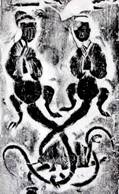
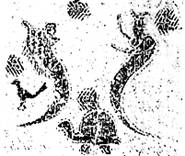
Nüwa and Xuanwu Fuxi Nüwa and Xuanwu (from the No.3 stone coffin
in Mt. Guitou, Jianyang, Sichuan)
In addition to the theme images of Fuxi, Nüwa, and Xuanwu, on the pictorial bricks, there are auxiliary images of bear, toad, Shenshu (Yulü)(the legendary immortals who can subdue the evils), tiger and Qingqi (a legendary atrocious tiger-like monster), etc., all of them are the mythical monsters of the “ Four Fiends” in remote antiquity of China, and they have been deemed to be capable of fending off demons, reversing the adversity, and bringing auspiciousness.
Based on the sorted sources so far, we found that not late than Mid-Western Han period, images of Fu Xi and Nüwa had appeared, mostly in tomb murals in and around Luoyang of Mid-Western Han to early Eastern Han period. Additionally, They were widely seen on the pictorial bricks and stones uncovered, as known in Henan, Shandong, Anhui, Northern Shanxi, Sichuan, Jiangsu, Beijing, and Yunnan, etc.
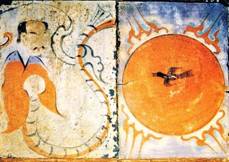
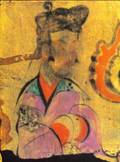
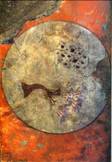
Fuxi/Nüwa and Sun/Moon Wall Paintings in Bo Qianqiu's Tomb (Western Han), Luoyang
Nanyang: In Henan Province, Fuxi and Nüwa images are mostly discovered in Nanyang, and universally date from Eastern Han period. In those images, Fuxi and Nüwa were painted either alone or in pairs. The articles held in their hands vary, including glossy ganoderma, canopy, compass and square, and moon, etc.
Northern Anhui and Northern Jiangxu: The images of Fuxi and Nüwa were mostly unearthed in Xiaoxian County, Anhui Province, and Huaibei, Xuzhou in Jiangsu Province (mostly date back to Eastern Han period), in which Fuxi and Nüwa either have snake tails or dragon tails, in intertwining or splitting posture, and largely decorated with scales. Generally, Fu Xi and Nüwa have hands crossed on their chests, and in some of the images, their hands holding articles, such as compass and square, sun and moon, etc.
Shandong: Most of the images of Fuxi and Nüwa discovered in Shandong Province date from the Eastern Han period. In most of those images, they hold compass and ruler in their hands, and have snake or dragon like tails, which interlocked or parted.
What’s more, they are often seen with the image of Si Wangmu (lit.Queen Mother of the West). The worship to and popularity of Si Wangmu was ascribed to Han people's wishes for longevity and the belief in immortality of the time. In the mythological world related to Si Wangmu, she is the primary deity, always flanked by the paired gods Fuxi and Nüwa.
Sichuan: The Fuxi and Nüwa images in Sichuan mostly date back to the period from the Eastern Han to Shu kingdom of the Three Kingdoms. Fuxi and Nüwa are usually seen in pairs, with snake tails exclusively, interlocked or parted. Partially they were painted with two wings, with something in their hands, mostly the Sun and the Moon, and in lunar or solar halos were frequently the Golden Crow, Jade Rabbit, and Cassia trees. Sometimes compass and square, bizarre crops, musical instruments, scarf and ribbons, etc. were seen holding in their hands. Images of Fu Xi and Nüwa in this area have various forms and their postures present a remarkable dynamic effect.
Northern Shaanxi: No sufficient images of Fuxi and Nüwa have been found in this region, most of them date from the Mid-Eastern Han period, and are frequently grouped with the auspicious beasts, such as the Azure Dragon, the Vermilion Bird, and the White Tiger, etc. Fuxi and Nüwa often have a human head and a snake like body, with hands joined in front of chest, rarely seen holding anything. Some rubbings of Fuxi & Nüwa from different places as followings:




Fuxi & Nüwa (Nanyang) Fuxi & Nüwa Relief (Xuzhou) Fuxi & Nüwa Relief (Liujiawan, Suide, Shaanxi)

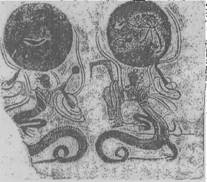
Fuxi & Nüwa on No.1 Coffin, Danxian, Sichuan Fuxi & Nüwa on pictorial brick (Chengdu suburb, Sichuan)
During Wei Kingdom of the Three Kingdoms to the Western Jin period, the rulers spared no effects to urge thrifty burial practice, which led to changes to burial customs, and as a result, tombs with paintings, once prevailed in central China, came to a full decline, thus the images of Fuxi and Nüwa were barely seen in the tombs in this area thereafter. However, in the tombs and grottos in the northern frontier during the Wei, Jin, the Northern Dynasty periods, such as the Hexi area of Gansu, and the tombs of koguryo at eastern Liaoning, paintings of Fu Xi and Nüwa could still be found. What’s more, quite a lot Fu Xi--Nüwa paintings on silk or jute, generally in trapezoidal shapes (wide top, narrow bottom), were discovered in the tombs of Tang Dynasty, at Astana, Turpan, Xinjiang, The faces and costumes of Fu Xi and Nü Wa bear the typical Han characteristics, combined with the influences of those ethnic minority groups in the Western Regions.
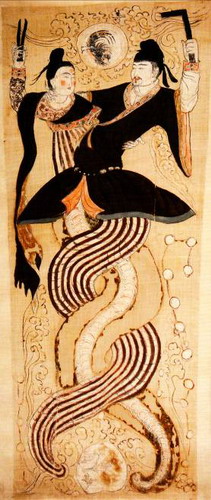
In the Pictorial Brick with Fuxi and Nüwa Relief, both of them hold something in their hands, do you know what they are?
Your answer please, if you have any questions or answer, please feel free to send us email, we are waiting for your answers and participation, and your comments, answers and suggestions will be highly appreciated. We will select and publicize the most appropriate answers and comments some time in the future.
Weekly Selection Email: meizhouyipin@chnmus.net
Pictorial bricks of Han Dynasty in Nanyang region
Nanyang Pictorial bricks of Han Dynasty, predominantly unearthed at a couple of counties around Nanyang city, namely, Dengzhou, Xinye, Xichuan, Tanhe, and Fangcheng, etc., dated from the Mid-late Western Han to the Mid-Eastern Han period, are divided into two types: hollow and solid, and their forms vary with their positions in the layout of the tombs. Scenes on these brick relief include feasting, hunting, outing, historical stories, myth and legends, ascending immortals, counteracting evil forces, and seeking auspiciousness, etc.

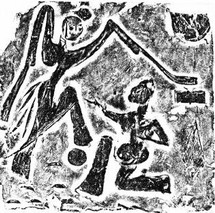
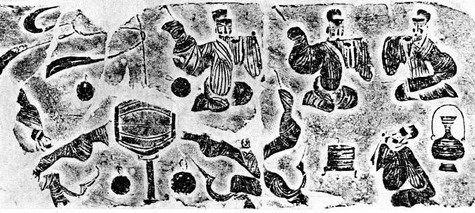
Bird Shooting Image
The upper part of the pictorial brick is about shooting birds, a common theme in Han paintings. Usually such images feature a centered big tree, underneath a archer is shooting the birds or monkeys in the tree. Mr. Yitian Xing, a Taiwan scholar, believes that these images should be called Images of Shooting Marquisate and Baronage. In ancient Chinese classics, sparrow is synonymous with baron, i.e. aiming at bird under the tree signifies obtaining official ranks. The Chinese character 猴(monkey) shares the identical pronunciation, and is interchangeable with“侯”(baron). In Han Dynasty, there was a twenty-ranks system of baronage, atop are two: Che Hou(Full Marquis) and Guannei Hou(Marquis of the Imperial Domain).Shooting at Jue (marquisate) and baronage both imply the wishes for nobility and wealth .
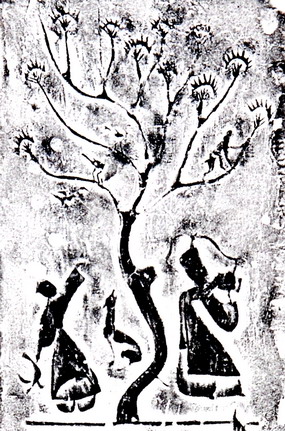
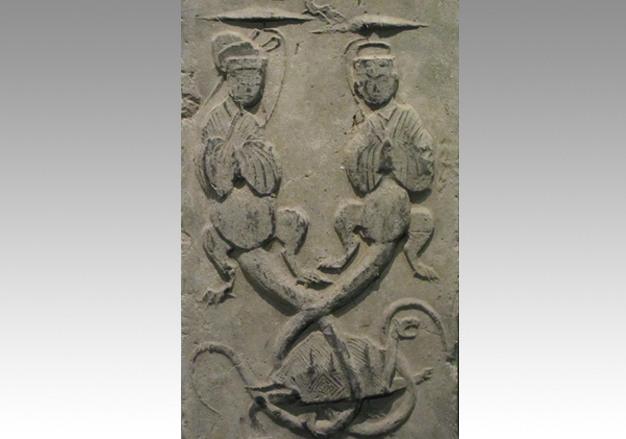
Title: Pictorial Brick with Fuxi and Nüwa Relief Carving
Period: Eastern Han Dynasty (25 A.D. – 220 A.D.)
Measurements: H. 100 cm, W. 33 cm
Provenance: unearthed from Fanji township, Xinye county, Nanyang city, Henan